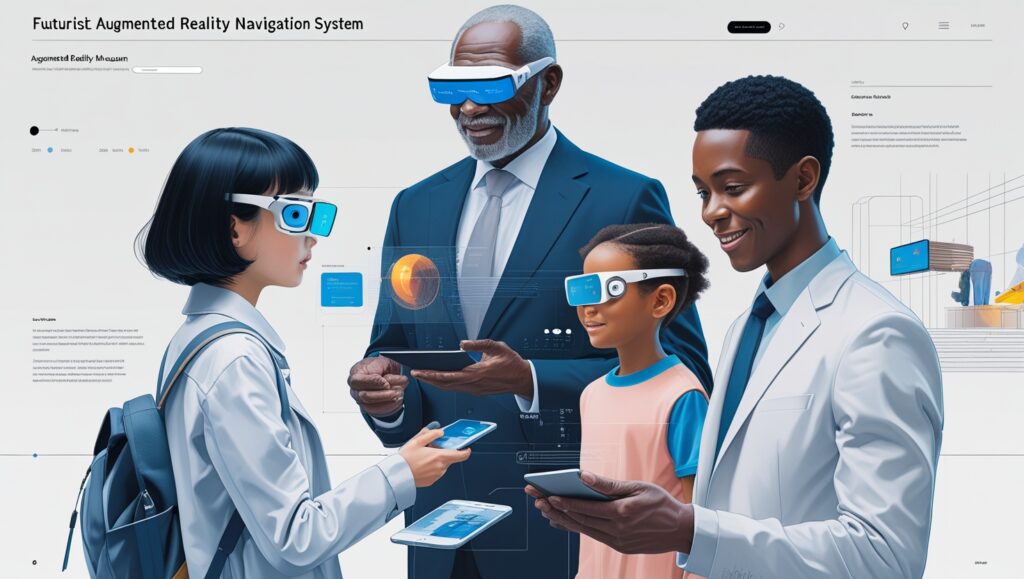Designing AR Museum Navigation: Best Practices
Let’s talk about making museum visits better – specifically, with augmented reality. Museums are often fantastic places, right? But they can also be… overwhelming. You wander around, trying to figure out where to go, what to look at, and what it all means. AR can solve some of those problems, and a big part of that is good navigation. It’s not just about pointing arrows at people; it’s about creating an experience that feels intuitive and actually adds to the visit. The trick isn’t just to bolt AR onto an existing map. It’s about rethinking how people find their way around, and how to tell stories while doing it. Honestly, it’s easy to get lost in the tech, but the goal should always be clearer access to the art and information.
The Core Idea: Why AR for Museum Navigation?
Okay, so why bother with AR at all? Well, think about how frustrating traditional museum maps can be. They’re often static, hard to read, and don’t offer much context. AR lets you overlay digital information onto the real world – right within the visitor’s view. Instead of squinting at a paper map, someone could point their phone at a hallway and see interactive directions appear, showing them the route to a specific exhibit. It’s also great for accessibility. Imagine providing audio descriptions through AR, or translating exhibit labels into multiple languages in real time. We’ve seen museums experiment with tools like ARKit (Apple) and ARCore (Google) to build these experiences. They’re the foundation for recognizing surfaces and tracking movement, which is crucial for believable AR. What people often miss, though, is the human side. AR shouldn’t feel like a tech demo; it needs to be integrated seamlessly into the museum’s atmosphere. And honestly, those initial demos weren’t always seamless.
Planning Your AR Museum Navigation System
Before you even think about code, you need a plan. First, map out the visitor journey. What are the most common routes? Where do people get lost? What information do they need at each point? Consider the physical space itself. Is the museum brightly lit, or are there dark corners? Lighting affects AR tracking, so you might need to adjust your approach. Tools that can help you map the space include spatial mapping software and even simple floor plan apps, then augment them with AR tools later. You also need to define your AR ‘triggers’. These are the things that activate the AR experience – maybe it’s a QR code, a specific image, or just a location. QR codes are the simplest to implement, but they can feel a bit clunky. Image recognition is more elegant, but it requires more processing power. GPS can work outdoors, within the museum itself, though, it can be unreliable. Common mistakes involve overly complex interfaces. Keep it simple, focused, and easy to use. A confusing AR interface is worse than no AR at all.
Choosing the Right AR Tools
So, you’ve got a plan – now what about tools? There are a few main routes you can take. First, there are dedicated AR development platforms like Unity with AR Foundation, or Unreal Engine with AR support. These offer a lot of flexibility, but they require significant programming expertise. Then there are no-code/low-code AR builders like Zapworks, Blippar, or Assemblr. These are great for prototyping and creating simpler AR experiences without writing a lot of code. But they often have limitations in terms of customization and functionality. Another common source of confusion is which SDK to use. ARKit and ARCore are the big players, but there are also cross-platform SDKs like Vuforia. Each has its strengths and weaknesses, so it’s important to choose the right one for your needs. A lot of museums start with basic AR apps built with web-based AR frameworks (like 8th Wall) to test the waters. These are accessible via a browser, so users don’t need to download anything. It’s a good way for smaller museums to start. Starting with something small, a single, well-executed AR navigation feature, is a smart move.
Designing the AR Interface: Less is More
This is where things get really important. An AR interface should be unobtrusive and intuitive. Don’t clutter the visitor’s view with too much information. Prioritize clarity and ease of use. Use clear, concise icons and text. Consider using spatial audio to guide visitors – sounds can lead them in the right direction without distracting from the visual experience. Color plays a big role, too. Choose colors that are visually appealing and don’t clash with the artwork. Avoid overly bright or saturated colors. What people get wrong a lot is assuming everyone understands AR conventions. Don’t assume that visitors know how to interact with the interface. Provide clear instructions and visual cues. Testing, and then more testing, is vital. Observe how real people interact with the AR navigation system. What do they struggle with? What do they find helpful? Iterate based on their feedback. We once built an AR experience where the directions floated above people’s heads. It looked cool, but people kept walking into things. Learned that one the hard way.
Examples of Successful AR Museum Navigation
Let’s look at a few museums doing this well. The Smithsonian National Museum of Natural History uses an AR app to guide visitors through the exhibits and provide additional information about the specimens. It’s well integrated and doesn’t feel intrusive. Another cool example is the Louvre Museum in Paris, which has experimented with AR to create immersive experiences that bring the artwork to life. They used AR to reconstruct missing parts of sculptures, allowing visitors to see them as they would have originally appeared. The Cincinnati Art Museum has used AR to help visitors explore the collections and learn more about the artists. They focused on creating a conversational AR guide that felt personal. What these examples have in common is that they prioritize user experience and focus on enhancing the overall museum visit. They don’t just add AR for the sake of it; they use it to solve real problems and create meaningful interactions. It shows a clear purpose.
Accessibility Considerations in AR Navigation
Accessibility is crucial. AR navigation shouldn’t exclude anyone. Provide options for different visual impairments. For example, you could use larger text, high-contrast colors, or audio descriptions. Consider users with mobility limitations. Can they access all areas of the museum with the AR navigation system? Make sure the AR interface is compatible with screen readers. Offer multiple language options. Test the AR navigation system with people with disabilities to ensure it’s inclusive and usable. It’s easy to overlook these details, but they can make a huge difference to someone’s experience. What often happens is designers focus so much on the tech that they forget about the people who will actually be using it. It’s a common trap, and one that can be avoided with careful planning and testing.
Dealing with Technical Challenges
AR isn’t always smooth sailing. There will be technical challenges. Tracking can be unreliable in certain environments, especially those with poor lighting or reflective surfaces. Connectivity can be an issue, especially in older museum buildings with thick walls. Battery drain is another concern. AR apps can consume a lot of power. Performance optimization is vital. Make sure the AR app runs smoothly on a variety of devices. What people often underestimate is the complexity of managing AR content. You need a system for updating the AR experiences, adding new features, and fixing bugs. It’s not a one-time project; it’s an ongoing process. Cloud-based AR platforms can help with content management, but they also introduce their own set of challenges.
Testing and Iteration: The Key to Success
Seriously – test everything. Test on different devices, in different lighting conditions, with different users. Gather feedback and iterate on your design. Don’t be afraid to scrap things that aren’t working. User testing is the most valuable thing you can do. Watch how people interact with the AR navigation system. Ask them questions. Listen to their feedback. What we found, repeatedly, is that our initial assumptions were often wrong. We’d think something was clear and intuitive, only to discover that visitors were completely confused. So, yeah – test, iterate, and be prepared to change your plans.
Future Trends in AR Museum Navigation
What’s next for AR museum navigation? We’re likely to see more sophisticated spatial mapping and object recognition. AR will become more integrated with other technologies like AI and machine learning. Imagine an AR guide that can answer your questions about the artwork in real time, or personalize the experience based on your interests. We’ll probably see more museums using AR to create gamified experiences and interactive tours. The possibilities are endless. Think spatial computing, personalized tours, and AI-powered object recognition. AR is evolving quickly. The key is to stay flexible and be open to new ideas.
Maintaining and Updating Your AR System
Don’t launch and forget. AR systems need ongoing maintenance and updates. Apps need to be updated to support new devices and operating systems. Content needs to be refreshed and revised. Bugs need to be fixed. Security needs to be monitored. It’s a continuous process. You’ll need a dedicated team or partner to manage the AR system. Building a content management system is key to efficient maintenance. It allows you to easily update the AR experiences without having to rebuild the entire app. Consider a subscription model for ongoing support and updates. Frequent updates show users you haven’t abandoned the project.
Cost Considerations for AR Navigation
Let’s be real: AR isn’t cheap. Development costs can vary widely depending on the complexity of the AR experience. You’ll need to factor in the cost of hardware (devices for visitors to use, or ensuring compatibility with their own devices), software licenses, and ongoing maintenance. Consider a phased rollout. Start with a small pilot project and gradually expand the AR navigation system as your budget allows. Focus on the areas where AR can have the biggest impact. What many museums forget is the cost of training staff to support the AR system. Someone needs to be able to troubleshoot problems and assist visitors. And don’t underestimate the cost of marketing the AR experience to visitors.
Measuring the Success of Your AR Navigation
How do you know if your AR navigation system is working? Track key metrics like user engagement, completion rates, and visitor satisfaction. Use analytics to monitor how people are interacting with the AR experiences. Collect feedback through surveys and interviews. Observe how visitors are using the AR navigation system in the museum. What we’ve found is that increased dwell time in exhibits is a good indicator of success. If people are spending more time looking at the artwork, it suggests that the AR navigation system is helping them to connect with the exhibits. Improvements in visitor satisfaction scores are another good sign. Use A/B testing to compare different AR navigation approaches and identify what works best.
Quick Takeaways
- Keep it Simple: Don’t overwhelm visitors with too much information.
- Prioritize User Experience: AR should enhance the visit, not detract from it.
- Test, Test, Test: Gather feedback and iterate on your design.
- Accessibility Matters: Ensure AR is inclusive and usable for everyone.
- Plan for Maintenance: AR systems need ongoing updates and support.
- Focus on Purpose: AR should solve a real problem, not just be flashy.
- Don’t Get Lost in the Tech: Remember the goal is the art, not the augmented reality.
Conclusion
Designing AR museum navigation is a tricky process, but it’s also incredibly rewarding. When done right, AR can transform the museum experience, making it more engaging, accessible, and informative. Don’t be afraid to experiment, to learn from your mistakes, and to iterate on your design. We learned the hard way that perfection is the enemy of good. Sometimes, a simple, well-executed AR navigation system is better than a complex, feature-rich one that nobody uses. The future of museums is undoubtedly intertwined with AR, and those who embrace this technology thoughtfully and strategically will be the ones who thrive.
FAQs
• What is the minimum level of technical expertise needed to implement AR navigation?
It really depends on the approach. Using a no-code/low-code AR builder requires minimal coding experience. However, for more complex AR experiences, you’ll need developers with expertise in AR development platforms like Unity or Unreal Engine. Consider partnering with an AR development agency if you don’t have in-house expertise.
• How can museums ensure the privacy of their visitors when using AR navigation?
Transparency is key. Clearly explain to visitors how their data is being collected and used. Obtain consent before collecting any personal information. Anonymize data whenever possible. Comply with all relevant privacy regulations, such as GDPR and CCPA.
• What are the biggest challenges in implementing AR navigation in historic buildings?
Historic buildings often have poor lighting, thick walls, and unreliable Wi-Fi. These factors can all pose challenges for AR tracking and connectivity. You may need to use specialized AR hardware or software to overcome these limitations. Carefully consider the impact of AR on the building’s historic character.
• How do you choose between using QR codes, image recognition, or GPS for AR triggers?
QR codes are the simplest and most reliable option, but they can feel clunky. Image recognition is more elegant, but it requires more processing power. GPS can work outdoors, but it’s often unreliable indoors. Consider the specific needs of your museum and the technical capabilities of your visitors.
• What’s a realistic budget for a basic AR museum navigation system?
A basic system, using a no-code platform and a limited scope, might cost between $5,000 and $15,000. A more complex system, developed with custom code, could easily cost $50,000 or more. The cost will depend on the features, the complexity, and the development time.


